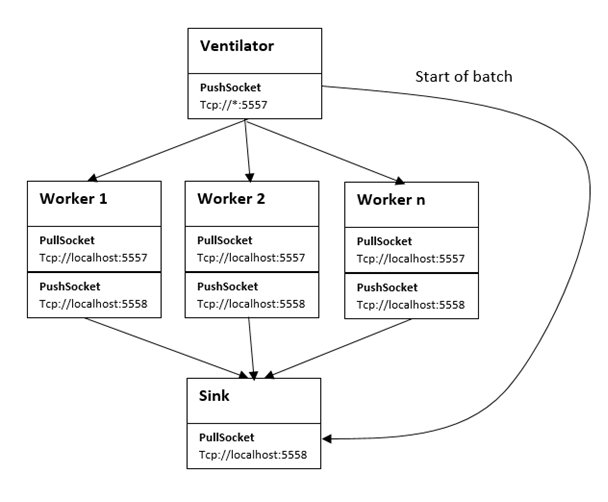NetMQ: Efficient Inter-Process Communication
 Guilherme Martin
Guilherme Martin
Introduction
Welcome to the NetMQ tutorial, where we explore the capabilities of NetMQ, a .NET library that extends the efficiency and flexibility of ZeroMQ. In this guide, we'll focus on two fundamental messaging patterns: Publish-Subscribe (Pub-Sub) 📢 and Request-Reply (Req-Rep) 🔄.
What is NETMQ?
NetMQ extends the standard socket interface with features traditionally provided by specialized messaging middleware products. NetMQ sockets provide an abstraction of asynchronous message queues, multiple messaging patterns, message filtering (subscriptions), seamless access to multiple transport protocols, and more. - NetMQ Documentation
NETMQ vs Traditional Message Queues
In the realm of message queues, NetMQ distinguishes itself from traditional counterparts through its emphasis on asynchronous messaging and a versatile socket-based communication model. Unlike traditional queues that often rely on synchronous communication, NetMQ enables non-blocking interactions, allowing applications to continue processing seamlessly while awaiting messages.
Built on ZeroMQ's foundation, NetMQ supports various socket types, offering developers a more adaptable and efficient approach to communication. Moreover, NetMQ operates with a server-less architecture, eliminating the need for a central server or broker. This design choice simplifies deployment and enhances system resilience, providing a robust foundation for distributed systems.
With a focus on zero-copy messaging, NetMQ optimizes data transfer efficiency, minimizing unnecessary memory copies during message transmission. Its extensibility and flexibility further set it apart, allowing developers to implement custom messaging patterns and tailor the library to specific application requirements. In summary, NetMQ emerges as a compelling alternative, offering asynchronous communication, versatile sockets, and enhanced performance compared to traditional message queues.
Messaging Patterns
NetMQ introduces a spectrum of messaging patterns that go beyond traditional message queues, providing developers with powerful tools to build efficient and decoupled systems.
Publish-Subscribe (Pub-Sub) 📢
In the Pub-Sub pattern, NetMQ facilitates broadcasting messages from a single publisher to multiple subscribers. Publishers categorize messages into topics, and subscribers selectively receive messages based on their subscriptions. This pattern is ideal for scenarios where information needs to be disseminated to a diverse set of recipients without the sender being aware of the subscribers' identities.
Request-Reply (Req-Rep) 🔄
NetMQ's Request-Reply pattern establishes a robust, synchronous communication model between a requester and one or more responders. The requester sends a request message and awaits a corresponding response from the responder. This pattern is well-suited for scenarios where a clear exchange of information and acknowledgment is necessary, ensuring a reliable and orderly communication flow.
Push-Pull, Pair (Exploration Continues)
While our primary focus is on Pub-Sub and Req-Rep, NetMQ offers additional patterns like Push-Pull and Pair, each catering to specific communication scenarios. In this tutorial, we'll delve into the details of Pub-Sub and Req-Rep, providing practical insights and examples to demonstrate their implementation.
Now, let's explore the Publish-Subscribe (Pub-Sub) pattern in more detail.
Pub-Sub Pattern
Subscriber
/// <summary>
/// Represents a ZeroMQ PUB-SUB pattern subscriber.
/// </summary>
public class ZeroMQPubSubConsumer
{
private static readonly string _consumerUrl = "tcp://127.0.0.1:5556";
/// <summary>
/// Registers the ZeroMQ subscriber and starts receiving messages in a PUB-SUB pattern.
/// </summary>
public static void RegisterZeroMQConsumer()
{
using (var subscriber = new SubscriberSocket())
{
subscriber.Connect(_consumerUrl);
subscriber.Subscribe("");
Console.WriteLine("Subscriber: Ready to receive messages.");
while (true)
{
string message = subscriber.ReceiveFrameString();
Console.WriteLine($"Received: {message}");
}
}
}
}
Publisher
/// <summary>
/// Represents a ZeroMQ PUB-SUB pattern publisher.
/// </summary>
public class ZeroMQPubSubPublisher
{
private static readonly string _publisherUrl = "tcp://127.0.0.1:5556";
/// <summary>
/// Registers the ZeroMQ publisher and starts sending messages in a PUB-SUB pattern.
/// </summary>
public static void RegisterZeroMQPublisher()
{
using (var publisher = new PublisherSocket())
{
publisher.Bind(_publisherUrl);
Console.WriteLine("Publisher: Ready to send messages.");
for (int i = 0; i < int.MaxValue; i++)
{
string message = $"Message {i}";
Console.WriteLine($"Sending: {message}");
publisher.SendFrame(message);
Thread.Sleep(1000);
}
Console.ReadLine();
}
}
}
Pub-Sub in Action 📢
The Pub-Sub pattern is a powerful tool for scenarios involving:
Event Notification Systems: Use Pub-Sub to notify multiple components or services about events without them knowing each other.
Real-time Updates: Implement real-time updates in applications where dynamic information needs to be broadcasted to various clients.
Distributed Systems: In a distributed architecture, Pub-Sub ensures seamless communication between different components.
Now, let's add the Request-Reply (Req-Rep) pattern.
Req-Rep Pattern
Requester
/// <summary>
/// Represents a ZeroMQ REQ-REP pattern requester (client).
/// </summary>
public class ZeroMQReqRepRequester
{
private static readonly string _serverUrl = "tcp://127.0.0.1:5556";
/// <summary>
/// Sends requests to the ZeroMQ REQ-REP server.
/// </summary>
public static void RegisterZeroMQRequester()
{
using (var requester = new RequestSocket())
{
requester.Connect(_serverUrl);
Console.WriteLine("Requester: Ready to send requests.");
// Simulate sending requests periodically
for (int i = 0; i < int.MaxValue; i++)
{
string request = $"Request {i}";
Console.WriteLine($"Sending request: {request}");
requester.SendFrame(request);
string response = requester.ReceiveFrameString();
Console.WriteLine($"Received response: {response}");
Thread.Sleep(1000);
}
Console.ReadLine();
}
}
}
Responder
/// <summary>
/// Represents a ZeroMQ REQ-REP pattern responder (server).
/// </summary>
public class ZeroMQReqRepResponder
{
private static readonly string _serverUrl = "tcp://127.0.0.1:5556";
/// <summary>
/// Listens for incoming requests and sends responses in the ZeroMQ REQ-REP pattern.
/// </summary>
public static void RegisterZeroMQResponder()
{
using (var responder = new ResponseSocket())
{
responder.Bind(_serverUrl);
Console.WriteLine("Responder: Ready to receive and process requests.");
while (true)
{
string request = responder.ReceiveFrameString();
Console.WriteLine($"Received request: {request}");
string response = $"Response to {request}";
Console.WriteLine($"Sending response: {response}");
responder.SendFrame(response);
}
}
}
}
Req-Rep in Action 🔄
The Request-Reply pattern proves beneficial in:
Microservices Communication: When microservices need to exchange information in a synchronous manner, Req-Rep ensures reliable communication.
Command-Query Separation: Adopt a clear separation between commands (requests) and queries (responses) in your system architecture.
Transactional Systems: Req-Rep is suitable for transactional systems where requests must be acknowledged with corresponding responses.
Final Thoughts 💭
These patterns represent just a glimpse into NetMQ's versatile capabilities. While we introduced additional patterns like Push-Pull and Pair, the tutorial primarily emphasized Pub-Sub and Req-Rep for a deeper understanding.
Feel free to explore more examples and code snippets in the ZeroMQ Examples GitHub repository, where you can access additional resources to further enhance your proficiency with NetMQ.
Thank you for joining this exploration of NetMQ's messaging patterns.
Happy coding!
Subscribe to my newsletter
Read articles from Guilherme Martin directly inside your inbox. Subscribe to the newsletter, and don't miss out.
Written by

Guilherme Martin
Guilherme Martin
As a skilled developer with a foundation in computer science, I specialize in the creation of distributed systems. Proficient in languages like C#, Python, and Java, I bring hands-on experience in building distributed ecosystems, incorporating technologies such as socket programming, NoSQL databases, file systems, caching mechanisms, and more. My focus centers on developing efficient and scalable solutions, demonstrating my commitment to the constantly changing landscape of distributed system development.